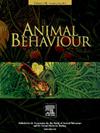Courtship is associated with greater spatial cognition and decreased boldness in a swordtail fish
IF 2.3
2区 生物学
Q2 BEHAVIORAL SCIENCES
引用次数: 0
Abstract
Alternative reproductive tactics (ARTs) offer a unique window into how sexual selection can shape cognition and nonreproductive behaviour. Sexual selection more broadly has been shown to shape cognitive traits but has rarely been investigated in the context of ARTs. Furthermore, the divergent morphology and sexual behaviour associated with ARTs may lead to different socioecological challenges (e.g. predation, space use) that further shape nonreproductive behaviours. We take advantage of the behavioural diversity in alternative reproductive tactics among male El Abra swordtails, Xiphophorus nigrensis, to ask how cognition and behaviour diverge between male tactics. We tested courting (large), coercive (small) and mixed-strategy (intermediate-sized) male phenotypes in four assays to evaluate boldness, aggression, exploration, spatial learning and spatiotemporal learning. We found that the courting-only large male phenotype had faster latencies to the reward in the spatial learning assay than the other two male phenotypes and also had greater accuracy than chance. Furthermore, we found that courting phenotypes (large and intermediate-sized males) had greater increases in accuracy over successive trials than the coercive-only small male phenotype. We also found that small, coercive male phenotypes were bolder than large and intermediate-sized males. We found no differences in aggressive behaviour (directed at a mirror) or spatiotemporal learning (shuttle box assay) across the three phenotypes. We suggest that courting males' superior spatial learning abilities may reflect their defence of females at ephemeral foraging patches as well as their need for reliable escape routes from predators. Coercive males' increased boldness may bolster their persistent behaviour and reflect reduced predation pressure. These results suggest that sexual selection for alternative reproductive strategies affects nonreproductive behaviour and cognition in directions that may align with divergent socioecological challenges associated with each mating type.
求偶与剑尾鱼空间认知能力增强和胆量减小有关
替代性繁殖策略(ARTs)为了解性选择如何塑造认知和非生殖行为提供了一个独特的窗口。更广泛地说,性选择已被证明可以塑造认知特征,但很少有人在ARTs的背景下进行研究。此外,与ART相关的不同形态和性行为可能会导致不同的社会生态挑战(如捕食、空间利用),从而进一步塑造非生殖行为。我们利用雄性艾尔-阿布拉剑尾鱼(Xiphophorus nigrensis)可供选择的繁殖策略的行为多样性,来探讨雄性策略之间的认知和行为差异。我们在四项试验中测试了求偶型(大型)、胁迫型(小型)和混合策略型(中型)雄性表型,以评估其胆量、攻击性、探索性、空间学习能力和时空学习能力。我们发现,与其他两种雄性表型相比,只求爱的大型雄性表型在空间学习实验中获得奖励的潜伏期更快,而且准确率也高于其他雄性表型。此外,我们还发现,求偶表型(大型雄性和中等体型雄性)在连续试验中的准确性提高幅度要大于仅有胁迫性的小型雄性表型。我们还发现,小型胁迫性雄性表型比大型和中等体型雄性更大胆。我们发现,三种表型的雄性在攻击行为(针对镜子)或时空学习(穿梭盒试验)方面没有差异。我们认为,求偶雄性的超强空间学习能力可能反映了它们在短暂的觅食斑块上对雌性的保护,以及它们需要可靠的逃离捕食者的路线。胁迫性雄性胆量的增加可能会加强它们的持久行为,并反映出捕食压力的降低。这些结果表明,替代性繁殖策略的性选择会影响非生产行为和认知,其方向可能与每种交配类型所面临的不同社会生态挑战相一致。
本文章由计算机程序翻译,如有差异,请以英文原文为准。
求助全文
约1分钟内获得全文
求助全文
来源期刊

Animal Behaviour
生物-动物学
CiteScore
4.60
自引率
8.00%
发文量
236
审稿时长
10.2 weeks
期刊介绍:
Growing interest in behavioural biology and the international reputation of Animal Behaviour prompted an expansion to monthly publication in 1989. Animal Behaviour continues to be the journal of choice for biologists, ethologists, psychologists, physiologists, and veterinarians with an interest in the subject.
 求助内容:
求助内容: 应助结果提醒方式:
应助结果提醒方式:


